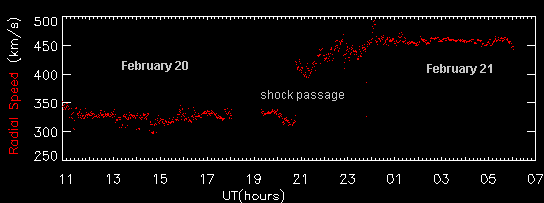 Space Science News home |
|
 Space Science News home |
|
|
February 21, 2000 -- An interplanetary wave of ionized
gas and magnetic fields passed by Earth on February 20, 2000
at 2100 UT. The shock front was caused by a full
halo coronal mass ejection (CME) that erupted from the Sun
on February 17, 2000. Geomagnetic activity has increased as a
result of the interplanetary wave, but it appears there will
be no significant aurora over the lower 48 U.S. states. The NOAA
Space Environment Center forecasts a 30% chance of minor geomagnetic
storm activity at middle latitudes today, decreasing to only
15% tomorrow. 
For more news and information about space weather, please see SpaceWeather.com. Technical information about current space weather conditions may be found at the NOAA Space Environment Center. |
| Web Links | |
Here Comes the Sun - February 18, 2000 Space Science News. A full halo coronal mass ejection appears headed directly for Earth. Small Sunspot, Big Flare - February 6, 2000 Space Science News. The brightest solar flare of the current solar cycle erupts from a diminutive sunspot group. Advanced Composition Explorer - home page. Solar Flares - Learn more about solar flares and coronal mass ejections at this excellent web site from NASA/Goddard. SpaceWeather.com -follow the latest events on the Sun Coronal Mass Ejections -from the Marshall Space Flight Center SOHO home page -real-time images, screen savers, and more |